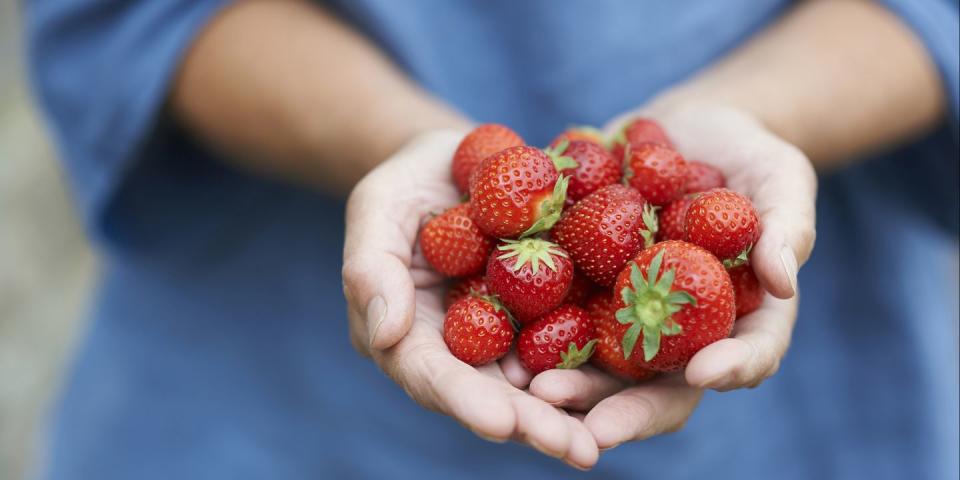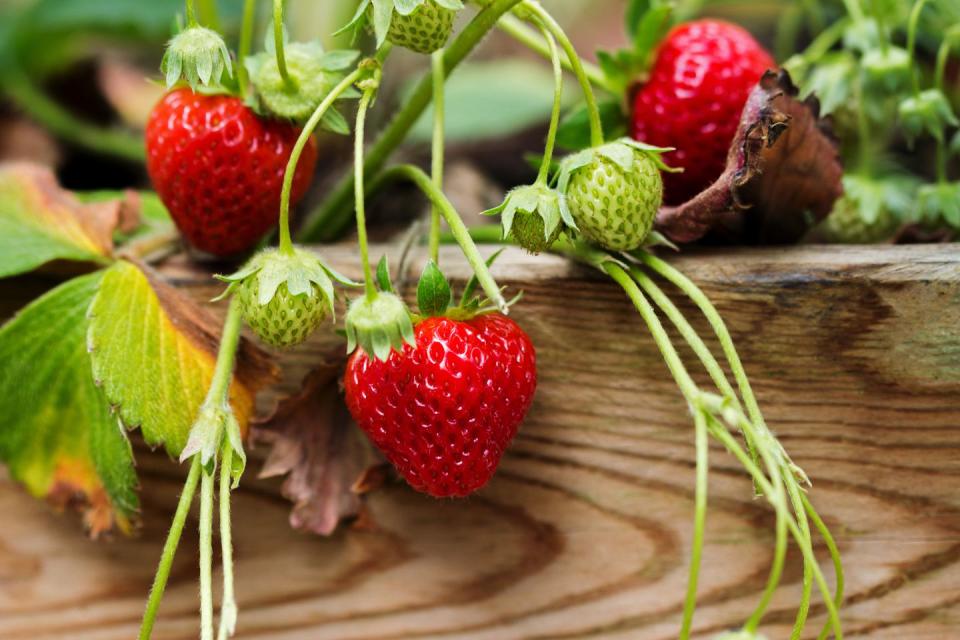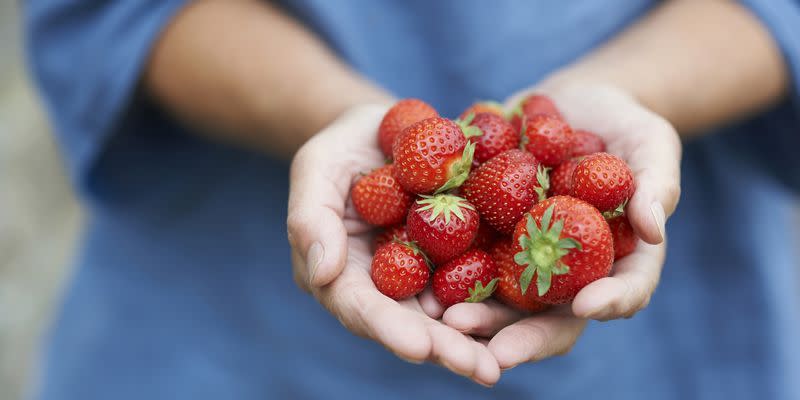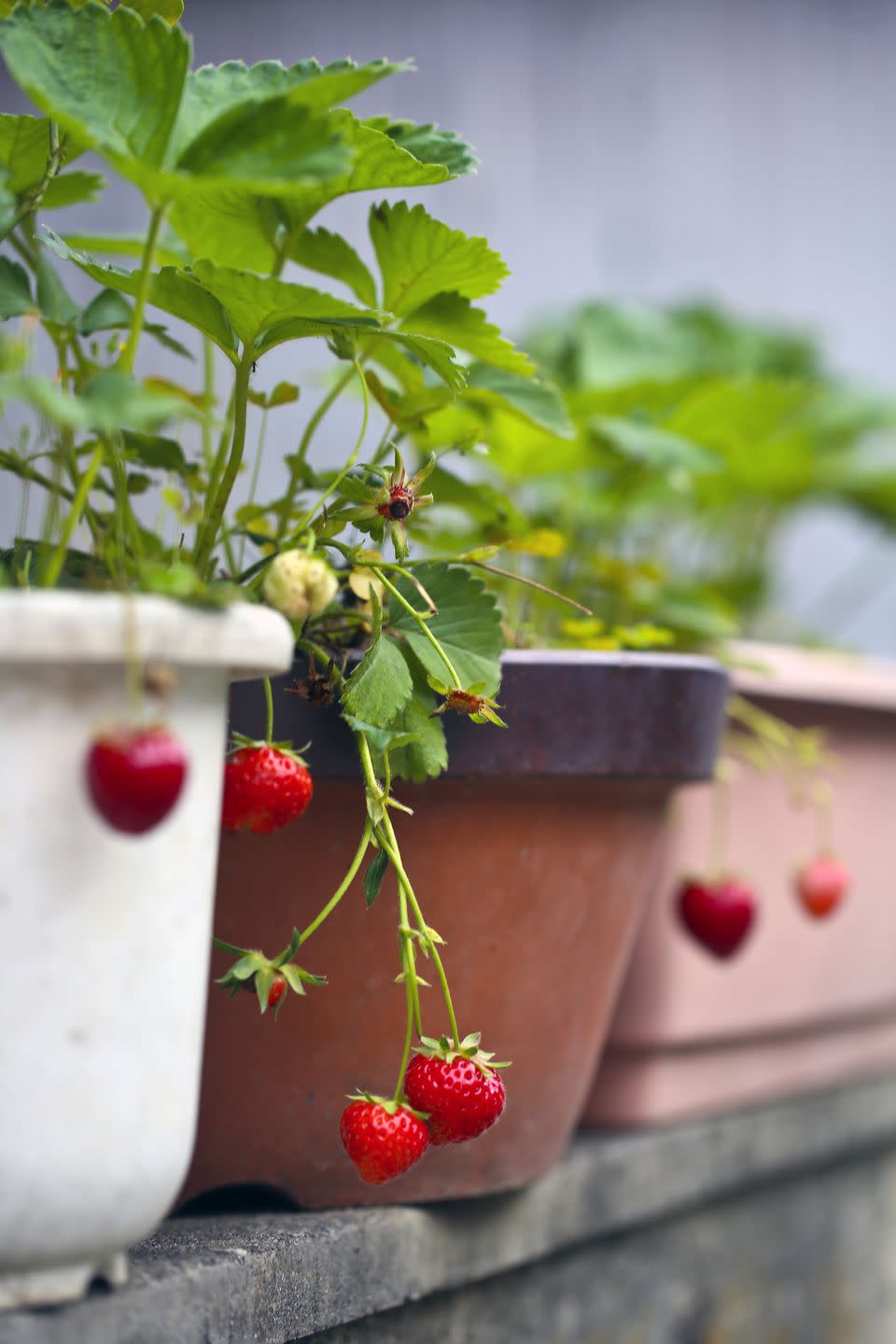An expert guide on how to grow strawberries in your garden

It’s hard to beat the taste of a homegrown strawberry and, as luck would have it, they are surprisingly simple to cultivate. Happy in the ground, pots, window boxes and even hanging baskets – with a little know-how, you can reap rewards from a few plants all summer long.
“Strawberries are one of the easiest fruits to cultivate,” says garden writer and veg grower Rob Smith. “They produce fruit from their first year, grow just about anywhere and don’t need any specialist care.”
How to grow strawberries
Tempted to try growing your own strawberries? After reading this expert guide, you’ll be able to enjoy ripe red fruits from early June right until the first frosts...
Which strawberry varieties should I choose?
Strawberries are broadly split into three categories. Summer-fruiting types produce large fruits in one big burst in June or July. Perpetual strawberries (also known as everbearers) produce smaller fruits but continue cropping all summer – ideal if you want regular handfuls for breakfast. Alpine strawberries (sometimes called woodland or wild strawberries) produce dainty but delicious fruit well into autumn. Within these broader categories sit hundreds of distinct varieties, each with unique characteristics and cropping times.
RHS Horticultural Fruit Specialist, Jim Arbury, recommends opting for a selection of early, mid-season and late summer-fruiting varieties, plus a few everbearers, meaning you’ll be able to enjoy a succession of fruits all summer, without a glut arriving all at once. Jim recommends ‘Honeoye’ (an early summer-fruiting variety), ‘Malling Centenary’ (a mid-season summer-fruiting variety) and ‘Florence’ (a late summer-fruiting variety), plus ‘Finesse’ and ‘Flamenco’, which are perpetual varieties.
Professional grower Marion Regan, whose family farm – Hugh Lowe Farms – supplies strawberries to Wimbledon, champions the appropriately named ‘Malling Ace’ – an everbearer which produces exceptional fruit all summer long.

‘Malling Centenary’ is another popular choice for professional growers, including Marion and Yorkshire-based producer Annabel Makin Jones. With a great size, flavour and tolerance of unpredictable English weather, the summer-fruiting variety boasts an RHS Award of Garden Merit (an award given to plants that have performed well in trials).
Garden writer and veg grower Rob Smith, meanwhile, favours ‘Honeoye’. “It’s probably the best tasting early variety,” he enthuses. Rob also likes ‘Pegasus’ – a mid to late season variety, which he says is perfect to follow on from ‘Honeyoye’, producing sweet, juicy fruits.
Alpine strawberries are grown less frequently, as their fruits are small and sporadic. Still, Monty Don has previously recommended the ‘Four Seasons’ variety, whose decent-sized plants produce an abundance of flavourful fruit all summer and into autumn.
THE BEST STRAWBERRY VARIETIES – RECOMMENDED BY EXPERTS
‘Honeoye’ – the “best tasting early variety” according to Rob Smith.
‘Malling Centenary’ – a mid-season summer-fruiting variety which boasts an RHS Award of Garden Merit, with big fruits and a beautiful flavour.
‘Florence’ – a late summer-fruiting variety, producing firm, flavourful red fruit.
‘Finesse’ – a perpetual variety, producing a good yield of fruit all season.
‘Flamenco’ – a perpetual variety, producing the peak of its fruit in September.
‘Malling Ace’ – a perpetual variety, producing exceptional fruit all summer long.
‘Four Seasons’ – Monty Don’s favourite Alpine variety, producing an abundance of flavourful fruit all summer and into autumn.
When should I plant strawberries?
You can plant strawberries in spring, early summer and autumn, depending on the method you choose. Bare-rooted runners (dormant plants which burst to life in spring) tend to be available to buy in spring and autumn. These should either be planted in the autumn, before the ground gets too cold and wet, or spring, after the risk of frost has passed. “Plant them as soon as possible as long as the soil isn’t frozen,” advises Rob.
Many ‘cold-stored runners’ promise to fruit sixty days after planting – making them ideal for gardeners in a hurry. These are available from spring to early summer.
Plug plants (young potted plants) are also usually on sale from spring into summer. These are favoured by Annabel, who recommends planting early in March, using fleece to protect them from frost, then removing it once the risk has passed after mid May.
TOP TIP: Buying bare root is often also cheaper than buying plug plants. It’s also better for the environment as there’s no peat or plastic.
Where should I plant strawberries?
Strawberries are traditionally grown in neat rows on a dedicated patch. “They do not need highly fertile soil but it should contain plenty of organic matter. Adding two bucketfuls of compost or soil improver per square metre before planting will improve results,” says Jim. “Raised beds are ideal where soil is clay, but not necessary in other situations,” he adds.
If you don’t have space for an entire patch, you can get creative. “Strawberries make beautiful (and tasty) bedding plants,” notes Rob. “You could dot plants around in different beds. Red and pink-petaled varieties – like ‘Toscana’ or ‘Summer Breeze Cherry’ – look so pretty.”
“Just make sure plants are on free draining soil to help avoid overwatering,” says Annabel. “And select a sunny spot, as strawberry plants thrive in sunshine.” Indeed, the importance of sunshine cannot be overstated. “Without enough light, flowers will be few and fruits may lack flavour and taste bitter,” warns Jim.
“Other than that, strawberries aren’t that fussy,” adds Rob: “I’ve grown them in clay, sandy soil and even grow bags!” Rob advises planting them 30cm apart, but stresses that the distance depends on variety. “Crowding plants leads to a short productive plant life,” adds Jim, who recommends spacing plants just over 30cm apart, leaving 90cm between rows.

How can I grow strawberries in pots?
“Strawberries can be grown in pots, window boxes, hanging baskets, troughs and even old welly boots,” says Rob. “Just make sure there is drainage and keep plants well watered.”
For best results, fill a large container with peat-free compost then plant one plug per 25cm container, adding more if yours is larger. Position in a sunny spot, and water every day, remembering that containers dry out much more quickly than beds.
“I also add horticultural wool to the bottom of containers and baskets as it soaks up excess water and acts as a reservoir, allowing the plants to access it later,” says Rob.

How can I grow strawberries from seed?
While summer-fruiting and perpetual varieties are only grown from runners or plug plants, you can grow Alpine strawberries from seed with relative ease.
“These make an attractive groundcover and, although their fruits are small, they are very flavoursome and especially appreciated by children,” says Jim. They are also a good choice for shadier spots, as, unlike other types, they can withstand less sunlight.
To grow strawberries from seed, simply sow indoors in small pots in spring or autumn, pricking seedlings around an inch apart once they have a couple of leaves. Plant out in May, either in the ground or a container, where fruits should continue to appear all summer.
How do I keep strawberry plants healthy?
“Strawberries need little attention,” says Jim. “Just ensure weeds are removed, they are watered in dry spells and given a light dressing of potassium rich fertiliser or mulch of well-rotted compost in late winter.”
Jim also recommends using nets to prevent birds from stripping the crop – and laying straw or special mats beneath fruit trusses before ripening, to keep them from rotting.
Once flowers start forming, Rob waters his plants weekly with tomato feed until they finish cropping. “But be careful to not overwater,” warns Annabel. “You can test this by feeling how damp the soil is. If it’s dry, they need more water. if it’s damp, they have had enough. If it’s soggy, they’ve been overwatered.”
Common problems like vine weevils (grubs that eat roots, causing plants to collapse) are easily avoided. “Vine weevils are more prevalent in potted plants with fine soil, so make sure to put a thick layer of grit on the top of pots to try and prevent them,” says Rob.
“Slugs can also be problematic in wet years,” adds Jim. “But a drench of anti-slug nematodes (microscopic worms that kill pests without chemicals) is very effective against slugs and vine weevils.”
To keep her plants in tip top condition – ensuring that energy goes into producing fruit rather than leaves – Marion removes runners (trailing shoots) when they emerge.
How do I harvest strawberries?
“Fruit should be red, bright, shiny and fragrant,” says Rob. “Don’t leave it too long on the plants, as they can attract blackbirds who will eat your entire crop!”
“I can tell they’re ready to harvest by the scent: you can't beat the aroma of ripe strawberries,” adds Marion.
What should I do with strawberry plants once they’ve fruited?
Well cared for strawberry plants should last up to four years, although Rob says they become less productive after year three. After flowering, Jim recommends giving plants a good trim – removing all the leaves to get rid of foliage problems. Once they have stopped being productive, dig them up and plant runners on a new patch or pot with fresh soil (this helps prevent disease).
Container plants, meanwhile, are best treated as annuals. “Pull them up once the fruiting season is over, so you can use the container for winter bedding,” says Rob.
Want to produce new strawberry plants for free? After fruiting, plants produce ‘runners’ which you can use as new plants. Fill small 9cm pots with compost, then, selecting the most robust-looking runners, pin them into pots with a bent wire – ensuring the runners remain attached to the main plant. After a few weeks, these new plantlets should have created their own root systems – and can be snipped away from the mother, for use as next year’s strawberry plants. “It’s so satisfying to create new plants for free!” says Rob.
You Might Also Like

 Yahoo Sport
Yahoo Sport 





































